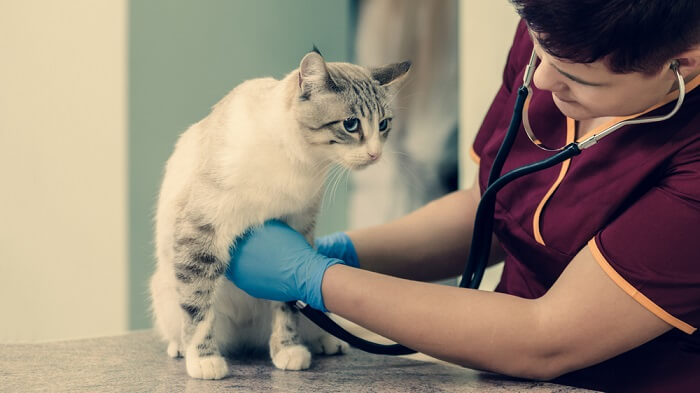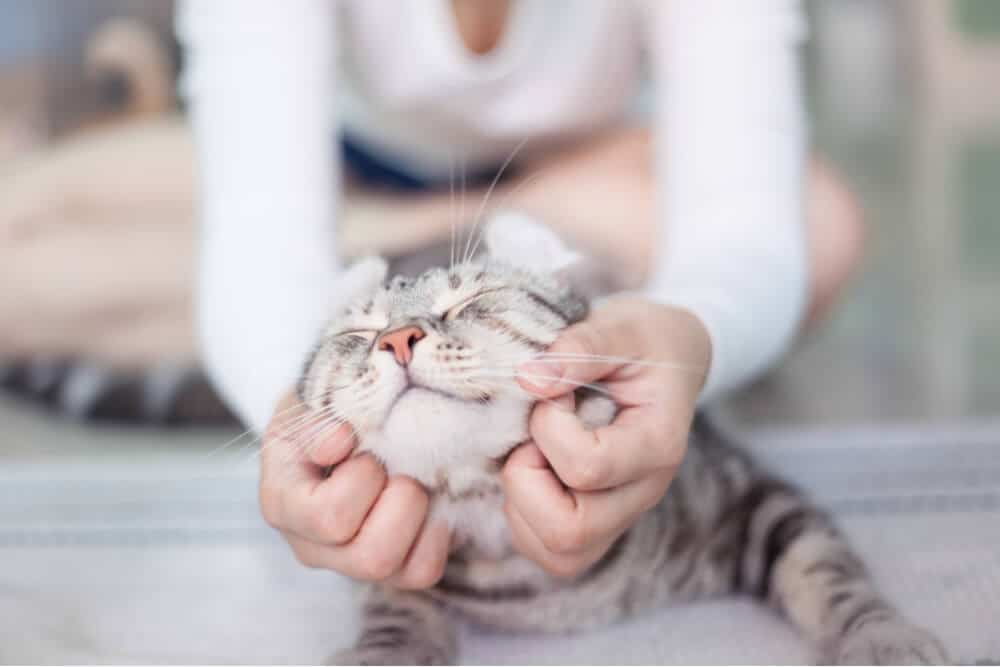
Xylitol is a chemical compound known as a “sugar alcohol.” It is commonly used in human foods and other products as a sweetener (e.g. sugarless gum). It is highly toxic to dogs, causing life-threatening health issues. In the past, there have been some concerns about possible toxicity in cats. The concern about xylitol poisoning in cats is no longer considered valid.
This article aims to explain the background of xylitol poisoning in cats so that cat owners can better understand the issue in more detail.
Quick Overview: Xylitol Poisoning In Cats





What Is Xylitol?
Xylitol is used as a sugar substitute in the form of an additive to specific human products. These include drugs, dietary supplements, confectionery/sweets, toothpaste, mouthwash, chewable mints, peanut butter, nasal sprays, medical tablets (such as melatonin), and sugar-free chewing gum. However, it is not commonly used as a separate ingredient in the home.
Xylitol creates a taste that is as sweet as sugar while containing 75% fewer carbohydrates and 40% fewer calories. It is sometimes used as an alternative to sugar for people with diabetes. This is because it does not raise blood glucose or insulin levels in humans.
About Xylitol Poisoning in Cats
There are many articles online about xylitol poisoning in cats. However, more recently, doubt has been cast on this information. It is now considered more likely that xylitol ingestion is not toxic to cats after all. The ASPCA website now states this clearly: “While xylitol consumption can be dangerous for your dog, it does not cause serious problems in cats.” This is good news for cat owners!
In a study in 2018, xylitol was given in large doses orally to six cats (up to 1000mg/kg). Xylitol ingestion caused no significant alterations in blood glucose in cats (other than a mild increase in blood glucose at the highest dose used).
From this study, it seems that cats are not susceptible to the dangerous hypoglycemia (low blood sugar) that is commonly seen in dogs that ingest xylitol. This supports the anecdotal clinical evidence seen by many vets in their practices.
There is an extra, possible concern of liver failure caused by xylitol found in dogs. The cats observed in the 2018 study were found to have normal liver enzymes. It is now considered doubtful that this is a significant concern.
How Xylitol Affects Cats
Xylitol is no longer thought to be toxic to cats. Furthermore, cats are far less likely than dogs to eat products such as sugar-free gum. This means that the risk of ingestion of xylitol is lower for cats in any case.
In dogs, xylitol toxicity causes a severe and dangerous drop in blood glucose by causing a surge in the release of insulin from the pancreas. This then requires prompt emergency veterinary intervention. There is an additional risk of hepatic necrosis (liver damage). Cats do not seem to be vulnerable to these toxic effects of xylitol.
How Much Xylitol Is Poisonous?

While xylitol is a safe sugar alternative for humans, it is toxic to dogs and used to be thought of as toxic for cats.
Contrary to previous beliefs, xylitol is not thought to be toxic to cats after moderate levels of ingestion (up to 1000mg/kg).
In dogs, xylitol is rapidly absorbed after ingestion. This results in hypoglycemia (low blood glucose) within half an hour. Doses of an amount of xylitol of over 100 mg/kg can result in hypoglycemia and over 500 mg/kg can result in hepatotoxicity.
Symptoms of Xylitol Poisoning in Cats
Cats are not thought to be susceptible to xylitol poisoning in doses up to 1000mg/kg. In contrast, dogs are highly vulnerable to xylitol toxicity at much lower doses.
The main signs of xylitol poisoning in dogs are linked to hypoglycemia (low blood glucose) and liver damage (hepatic necrosis).
Diagnosis of Xylitol Poisoning in Cats
While cats are no longer considered susceptible to xylitol poisoning, if you feel that your cat could benefit from a veterinary exam after consuming xylitol, there are a number of procedures that you can expect your vet to follow during the visit.
1. Detailed History Taking
During your cat’s examination, a vet will discuss every aspect of your cat’s background and overall care. The vet will also take down the details of when, how much, and what type, of xylitol has been consumed by your cat. The amount and type of xylitol that has been eaten will be identified. A local animal poison control center or a pet poison helpline may be contacted as part of this initial discussion to do specific calculations of risk.
2. Physical Examination

A thorough examination at the veterinarian may put your mind at ease if you suspect your cat has ingested something toxic.
Your veterinarian will check your cat over carefully, looking for any signs of ill health.
3. Routine Blood Tests
Your DVM veterinarian may carry out routine blood work. This can include the usual panel of diagnostic tests, such as hematology (blood count) and biochemistry profiles. These tests help to double-check for any damage to internal organs caused by xylitol.
Treatment of Xylitol Poisoning in Cats
Induction of emesis (vomiting) or gastric lavage can be an effective way of removing most toxins from the digestive system if it is carried out promptly. Ideally, this time frame should be within an hour of ingestion. Given the more recent understanding of the lack of toxicity of xylitol to cats, this may or may not be recommended by your veterinarian. It all depends on the specifics of the situation.
Activated charcoal may or may not be recommended in an attempt to limit the absorption of xylitol from the digestive tract.
General supportive treatment is important in any possible poisoning situation. This can include IV fluids, digestive tract protectants, and other medication to control any signs that the cat may be showing. This may or may not be suggested by your vet.
Prevention of Xylitol Poisoning in Cat
Pet owners should store all xylitol safely, out of the reach of pets. Xylitol should never be given to cats, even though recent evidence suggests that it is not toxic to cats, after all.
Xylitol and Cats: Final Thoughts

Take care to make sure that your cat is not likely to ingest anything that they shouldn’t be, even if it is thought to be generally non-toxic.
Xylitol is no longer thought to be poisonous to cats. However, if a cat is known to ingest xylitol in very high quantities, prompt action by taking the cat to the emergency clinic is still advised.
Also Read: 15 Human Foods That Are Poisonous & Toxic To Cats
Frequently Asked Questions
How much xylitol is toxic to cats?
Xylitol is no longer thought to be toxic to cats, but if doses higher than 1000mg/kg body weight are ingested, urgent veterinary advice needs to be sought.
How long does it take for xylitol poisoning to affect cats?
Cats do not show ill effects after ingesting xylitol, as it is no longer thought to be toxic to cats.
What happens if a cat eats xylitol?
Cats do not suffer toxicity after eating xylitol, but if they eat more than 1000mg.kg, there may be a risk of certain issues. In this case, they should be taken to the vet for urgent treatment.
How long does xylitol take to make a dog sick?
Dogs can develop symptoms of hypoglycemia (low blood sugar levels) within a very short time after ingestion of xylitol (e.g. 15 minutes), so they need to be taken to the vet with extreme urgency. Xylitol does not affect cats in this way so this advice does not apply to cats.







